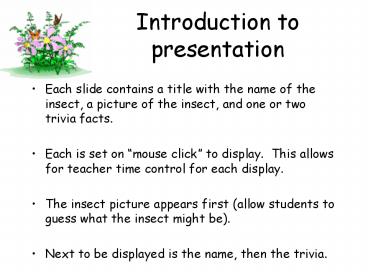Introduction to presentation - PowerPoint PPT Presentation
1 / 15
Title:
Introduction to presentation
Description:
Bulldog Ant. Bulldog ants belong to the ponerine family the largest, most colorful, and most ... American Cockroach. The American cockroach lives in North ... – PowerPoint PPT presentation
Number of Views:71
Avg rating:3.0/5.0
Title: Introduction to presentation
1
Introduction to presentation
- Each slide contains a title with the name of the
insect, a picture of the insect, and one or two
trivia facts. - Each is set on mouse click to display. This
allows for teacher time control for each display. - The insect picture appears first (allow students
to guess what the insect might be). - Next to be displayed is the name, then the trivia.
2
EXTREMELY WEIRD INSECTS!!
3
Brush-Snouted Weevil
- Weevils are beetles with very long heads, and
their eyes, elbowed antennae, and mouthparts are
set far apart from each other. - The brush-snouted weevil is a large beetle from
South America.
4
Harlequin Bug
- This harlequin bug is a nymph. In Greek and
Roman mythology, a nymph is a nature goddess. - In entomology (the study of insects), a nymph is
the young of any insect whose life cycle does not
include complete metamorphosis.
5
Shield Stinkbug
- Stinkbugs discharge a smelly liquid from two
pores on their underside when theyre disturbed. - This is a good way of keeping hungry
predators-who dont want a stinky mouthful-at bay.
6
Horsefly
- Although horseflies look as if they are wearing
great sunglasses, those shades are actually
eyes-compound eyes, that is! - Most insects have compound eyes that are made up
of hundreds of simple eyes placed together.
7
Bulldog Ant
- Bulldog ants belong to the ponerine family the
largest, most colorful, and most aggressive of
living ants! - These impressively large ants may reach a length
of of one inch (25mm).
8
Gulf Fritillary Butterfly
- The gulf fritillary lives in Central and South
America. - Some butterflies have taste organs on their feet
these are so sensitive, the butterflys proboscis
automatically uncoils at the first touch of a
tasty flower.
9
Deaths-Head Sphinx
- While resting, the caterpillar assumes a peculiar
position-head curved down below their thorax and
the front part of their body raised-which is much
like the posture of the Egyptian Sphinx. - This defensive, or threat, posture is an
effective way to scare away hungry predators.
10
Flat-Faced Katydid
- Male katydids make music by winging it. One
forewing is equipped with a file that is rubbed
against a scraper on the other forewing. - Males sing to attract a mate both males and
females have excellent hearing.
11
Giant Australian Stick
- Many animals depend on a disguise-protective
coloring or shape-to blend in with their
background and to hide from predators. - During the day, most stick and leaf insects stay
almost completely motionless-in strange
postures-made invisible by their resemblance to
the plants and trees around them.
12
Dewey Green Darner
- Darners are large, brightly colored dragonflies.
Like all members of their family, they have a
stout body, a large, movable head, and two pairs
of large veiny wings.
13
American Cockroach
- The American cockroach lives in North America,
but it originated in Africa. It grows to a
length of about one inch (roughly 25mm), which is
small compared to its 3-inch-long tropical
relatives.
14
Human Head Louse
- The human head louse belongs to a family of true
(or sucking) lice that live and feed only on
human primates. - True lice feed on blood that they draw from their
host with their piercing and sucking mouthparts.
15
Cicada
- The periodical cicada is famous for its 17-year
life cycle. Females lay their eggs in trees, and
the nymphs hatch in six weeks and drop to the
ground where they burrow. They remain in the
earth for 17 years, crawl to the surface, and
leave their old cuticles behind.































